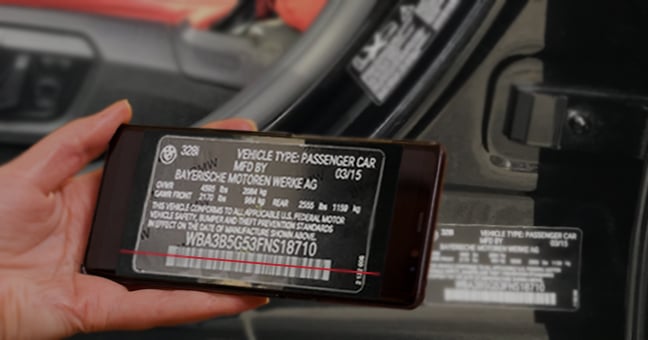

Jul 28 2021
VIN barcode scanners are a great feature for many apps in the automotive space, especially for business processes such as scanning in inventory or fleet assets, looking up the specs on a vehicle at auction, or an insurance adjuster resolving claims.
Whether you are developing an app that requires a VIN barcode scanner to help solve certain business processes or are looking to eliminate manual VIN entry from your internal processes, this article will help you understand both the basics of barcode scanning as well as how VIN barcode scanning works.
Barcode scanning is used for many different business applications, and at one point was only effective with a dedicated scanning device. However, barcode scanners built into a smart device’s camera have become just as effective, and more convenient, with the right scanning software.
There are two main barcode “symbology” categories, 1D (one-dimensional linear barcodes) and 2D (two-dimensional with rectangles, dots, hexagons, etc.), as well as different coding frameworks/libraries/APIs for each operating system. Integrating a barcode scanner into your app will require some development. So, where do you start?
There are a few ways you can integrate a barcode scanner into your application. You can either work with an open-source scanner, implement a fully built-out, plug-and-play commercial solution, or custom-develop your barcode scanner. The route you choose will largely depend on your development resources (including ongoing maintenance) and their technical abilities, the level of customization you require, and your budget.
There are a few open-source barcode scanner libraries to consider, including ZXing and ZBar. While open source barcode scanners are a free option, there may be limitations regarding speed, reliability, scan volume, support and maintenance, and other business requirements.
There are also commercial barcode scanner solutions, including Scandit and Dynamsoft, that might be great for your business. While a commercial solution is not free, it can end up saving your business money in development time, especially if your team is not very technical. These solutions require limited coding to implement, work well with multiple operating systems, and include customer support along the way. Additionally, they tend to function quickly, with greater flexibility for barcode imperfections.
If you’d prefer to build your custom scanner, Apple’s AVFoundation Capture framework and Android’s Barcode API have made this relatively simple to implement. This solution will give you the greatest level of customization within your application, but similar to open source libraries, it would require more development resources and may be challenging to support.
VIN barcodes are in Uniform Symbology Specification Code 39 (USS Code 39), which is built off the standard Code 39 (1D), but do not contain start and stop characters. As such, whichever route you decide to take, you’ll need to make sure it supports USS Code 39 barcode reading.
It doesn’t stop there. After the barcode scanner reads the barcode, you’ll need to decode the VIN to extract the vehicle information desired. This will require help from a VIN decoding solution, such as DataOne’s VIN Decoder API Web Service. Similar to the benefits of a commercial barcode scanner, a commercial VIN decoder will also offer several benefits over a free VIN decoder, as highlighted in this article.
Scanning VIN barcodes, or any barcodes for that matter, can present some challenges that you’ll want to be aware of as you look to integrate a VIN barcode scanner into your product(s) or application(s). Here’s a list of some potential challenges:
You’ll want to make sure that whichever scanning software you choose to license or develop addresses these hurdles. However, they may not all be applicable for your use case.
While there can be some challenges with VIN barcode scanning, they are outweighed by the benefits. One of the greatest benefits is the elimination of human error caused by manually entering VINs. Especially since VINs can be a challenge to read through the driver’s side windshield or sideways on the doorjamb. Another key benefit is greater speed/efficiency. This is particularly valuable for use cases such as auctions or dealership service drives, where this data needs to be available quickly.
The speed and accuracy of returned VIN decodes are just as important! If you still have a need for a reliable vehicle data solution to decode the scanned VINs, DataOne would be happy to discuss the details with you. Request more information by clicking the button below and filling out our RFI form.